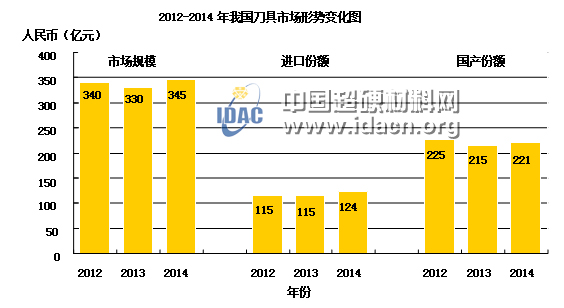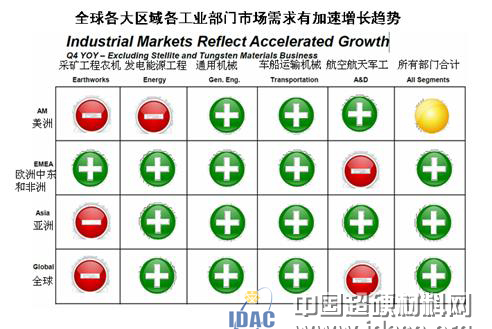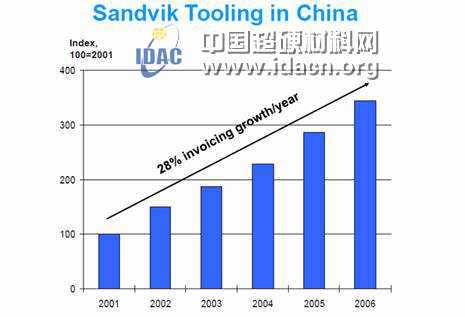Abstract 1. In 2015, the recovery momentum of China's tool market has encountered new challenges. After 2015, China's macroeconomic situation is generally stable, but the downward trend of the manufacturing industry has affected the tool sales system. The sales situation of a considerable number of tool companies is higher than last year. severe. root...
1. In 2015, the recovery momentum of China's tool market has encountered new challenges. After entering 2015, China's macroeconomic situation is generally stable, but the downward trend of the manufacturing industry has affected the tool sales system. The sales situation of a considerable number of tool companies is more severe than last year. According to the statistics of the tool clubs, in the second half of 2014, two-thirds of the sales of member companies maintained a good momentum of steady growth, reversed the downward trend for two consecutive years, achieved double sales and benefits, and also exported. Shows a strong rebound.

Figure 1 The size of the domestic tool market and the share of imported and domestic tools in the last three years
After entering 2015, the sales situation began to worsen in the fourth quarter of 2014. Less than a quarter of the companies participating in the statistics achieved sales growth, and the industry experienced an average negative growth of nearly 10%. In contrast, the proportion of sales growth in foreign companies in China has exceeded half since the beginning of this year, and the overall situation is better than domestic enterprises. From the macro and micro levels, the following is an analysis of the reasons for the twists and turns in the domestic tool market recovery process and the countermeasures that enterprises should take.
Second, the focus analysis of China's macroeconomic situation - the source of economic downward pressure and the countermeasures for steady growth
In the official report on the economic situation, there is a recurrence of a sentence. That is, “the economic operation is generally stable, but it is also facing greater downward pressure.†Where is the downward pressure? What is the trend?
The analysis believes that the downward pressure on the manufacturing industry is mainly reflected in overcapacity in some industries. But the essence of the problem is the lack of final demand, resulting in poor sales. The underlying cause of insufficient demand is still the impact of the “three-phase superposition†of the economic growth shift period, the structural adjustment pain period and the digestive period of the previous stimulus policy.
In order to change this situation, in recent years, the state has put forward clear guidelines for expanding domestic demand and transforming the development mode, and has made efforts to promote it. But statistics show that it is difficult to increase the consumption rate, and the current steady growth measures still depend on investment. On the basis of summarizing the experience and lessons of the extensive development model in the past, the government proposes to classify and guide investment in different fields, formulate a development policy with a focus on it, and directionalally exert its efforts to use the funds in the cutting edge to maximize the effect. Investment in the three major areas of infrastructure, real estate and manufacturing has its own focus and treatment.
About infrastructure investment. Experts pointed out that China has a lot of room for infrastructure construction and can rely on large investments to boost GDP. However, the current problem is that infrastructure construction mainly relies on local government investment, which is the biggest source of various ills and risks. Therefore, to expand infrastructure investment must adhere to two: first, select the right project, strive to have a market, have long-term returns, invest funds in a place that is in line with the direction of development; second, diversified sources of funds, can attract positive social funds Investment in infrastructure construction is the key to steady growth. To this end, we must promote the reform of the fiscal, taxation, financial and investment systems as a whole.
About real estate investment. The real estate industry has a crucial impact on steady growth, because it can create a large number of demand for dozens of industries upstream and downstream, is an important pillar of China's economic development, and is also an important starting point for stable growth. However, over the years, under the influence of local government land finance, currency oversupply and the lag of capital market development, the real estate industry has become the investment of choice, prompting its abnormal development and causing economic and social risks. On the basis of summing up lessons and deepening reforms, the new government has achieved remarkable results through the introduction of a series of policies. However, the overall situation of the current real estate industry is still in deep adjustment.
About manufacturing investment. Manufacturing is the foundation of the national economy, which has formed a broad consensus around the world. Manufacturing investment is an important aspect of steady growth, and it goes without saying. However, the majority opinion in China's economics circles hopes that the government will not directly interfere with the development of an industry. Past experience has shown that even in strategic emerging industries, the government intervenes, and all localities will rush to the top. The consequences are repeated investment, overcapacity, and even vicious competition. However, it is the most practical for enterprises to determine the direction of industrial and product structure adjustment according to market needs in development. The majority of enterprises hope that the government should focus on establishing a level playing field. At the same time, finance must adhere to the direction of serving the real economy. From the reality, the government still has a long way to go to create a more relaxed environment for enterprise development through deepening reform.
From the above analysis, we can see that the cause of the current economic downturn is that many deep-seated contradictions that have accumulated for a long time are prominent. Therefore, it is impossible to rely on the old methods to stabilize growth. It is necessary to deepen reforms, resolve conflict risks, and stimulate new impetus to be effective. China's economic development has entered a new normal, with new challenges and new opportunities.
The experience of recent years tells us that the fluctuation of the tool market is closely related to the expectation of the economic prospects in all aspects of the industry chain. The majority of enterprises need to do more work and do more research to prevent misjudgment of the situation.
Third, tool companies should have a better role in the new normal
In the face of a grim situation, the vast number of enterprises must be full of confidence, overcome difficulties, and strive for better work under the new normal. Through the following introduction and analysis of the development trend of global and Chinese manufacturing industry, enterprises will see that China and the global tool market have good development prospects, opportunities outweigh challenges, as long as they follow the pace of modern manufacturing development, aiming to improve labor productivity. This eternal theme, adjusting the product structure and improving the service level will definitely have a better job under the new normal and open up a new situation for enterprise development.
1. Seize the huge development opportunities brought about by the new normal
After the global financial crisis, with the attention of governments, the global machinery manufacturing industry is showing a good momentum of accelerated growth, and the tool market has good development prospects.
After the global financial crisis in 2008, developed countries summarized the lessons of industrial hollowing out to harm the economy and vigorously strengthened their attention to the development of manufacturing. Obama’s revitalization of manufacturing has begun to bear fruit. Some US manufacturing companies have begun to move back to their homeland, and emerging industries are gaining momentum. Japan has always raised manufacturing export competitiveness as the main means of revitalizing the economy; and manufacturing powerhouse Germany has launched “industrial 4.0â€, the core of this standard is “smart manufacturingâ€. German Chancellor Merkel said that she would push this standard to Europe and the world, and play a leading and leading role in the new round of manufacturing competition. China is the world's largest manufacturing industry, but big but not strong has always been the biggest obstacle to the further development of manufacturing. In this year's government work report, Premier Li Keqiang proposed to implement "Made in China 2025", adhere to innovation-driven, intelligent transformation, strengthen foundation, and green development, and accelerate the shift from a manufacturing power to a manufacturing power. In this process, intelligent manufacturing is the main direction of attack, and it is also the fundamental path from manufacturing power to manufacturing power.
Please note that in the context of the slow recovery of the global economy and the fragile growth momentum from time to time, countries have been vigorously supporting the development of the manufacturing industry without exception, showing the important position of manufacturing in the development of modern economy. It is thus convinced that the stable market prospects of the tool industry are unique. The vast number of tool companies must cherish this opportunity and turn it into a powerful driving force for “transfer mode and structure adjustmentâ€. Of course, at the same time, we must also see that in terms of our ability to serve the modern manufacturing industry, we have a large gap compared with our counterparts in developed countries. Therefore, in the future, in order to win the domestic and international market share competition, China's tool companies will face severe challenges.
Regarding the accelerated development of global manufacturing, KENNAMETAL published a research report (see Figure 2). As can be seen from Figure 2 (the green circular symbol indicates accelerated growth), except for some industries in a few regions, the world's continents have shown a general acceleration of manufacturing growth. Kenner's research also shows that demand in emerging markets such as Eastern Europe, South Korea, Latin America, India, and China will grow faster.

Figure 2 Global manufacturing industry generally shows a good momentum of accelerated growth
2. Tool companies should take the initiative to meet the challenges brought by the new normal
Under the background of the accelerated development of modern manufacturing industry, the contradiction between the product structure of China's tool enterprises and the overall poor service level has once again become prominent.
This issue is an old topic that our industry has discussed for more than 10 years. The focus of the problem is: modern manufacturing needs to be equipped with modern high-efficiency tools of “three high and one specialâ€, while domestic tool enterprises can supply large quantities of inefficient Traditional standard tool. The result of this gap in supporting capacity is that at the beginning of the new century, when China's modern manufacturing industry accelerated its development, the “three high and one special†high-efficiency tools required by the company were almost entirely dependent on imports. In those years, the sales of imported knives in China could be described by explosive growth. Figure 3 shows the surge in sales in China reported by Sandvik in 2001-2006.

Figure 3 Sandvik's sales in China grew at an average annual rate of 28% in 2001-2006
In recent years, this situation is changing with the development of domestic tool companies. Domestic high-efficiency tools have made great progress from scratch. At present, in the high-end tool market of the manufacturing industry, the proportion of domestically produced tools has risen to 25-30%. However, there have been new changes in the situation. As mentioned earlier, the global acceleration of manufacturing modernization, the demand for high-end tools is increasing. In the process of transfer mode and structure adjustment, the domestic manufacturing industry eliminated backward production capacity, reduced the demand for traditional standard tools, and increased the demand for high-end tools. This reduction between one plus one creates a new gap, highlighting the speed of product enterprise product structure adjustment, and once again lags far behind objective needs. Mainly in two aspects: (1) the speed of decline in traditional standard tool demand; (2) China's tool companies have insufficient ability to provide solutions for the manufacturing industry, and the service level is low, which has become a major bottleneck for further transformation and upgrading.
At present, a small number of tool companies in China have begun to work hard to improve their overall service capabilities, and have achieved initial results, but this is not enough. Judging from the needs of the development of modern manufacturing industry, all the tool companies entering this field must take the overall ability to provide comprehensive suggestions for improving the quality and efficiency of the manufacturing industry as a compulsory course.
3. Tool companies must correctly understand the profound connotation of the new normal
The economics circles pointed out that last year the central government proposed the concept of a new normal economy with profound strategic connotations. It is a high-level summary of the staged characteristics of China's economic development and a regular understanding of economic transformation and upgrading. From the current stage, the new normal has three major characteristics. First, the economy has changed from high-speed growth to medium-high-speed growth. Second, the economic structure has been continuously optimized and upgraded. Third, the development momentum has shifted from factor-driven and investment-driven to innovation-driven. From these three points, the first one, the economy has changed from high-speed growth to medium-high-speed growth, which has become a reality. The current task is to stabilize growth and prevent a downward trend in the economy. Article 2: The economic structure is continuously optimized and upgraded, and is currently underway. However, from the current situation of tool companies, the structural adjustment speed lags behind the development needs and should be accelerated. Article 3: The development momentum should be turned to the innovation drive. This article can be said to be the core and key to the transformation and upgrading under the new normal. It can be said that without innovation drive, there can be no real change in the development mode. At the Standing Committee of the Tool Branch held not long ago, some business leaders proposed that for a long time, on the important topic of innovation, everyone's understanding is often very narrow and one-sided. Such as: equating product and technological innovation with all innovations. In fact, in the practice of reform, organizational innovation, institutional innovation, etc. can often form a stronger driving force for development.
At the association meeting, this in-depth discussion of reform issues has been widely recognized and responded. We are looking forward to the reform and development of the tool industry. In the communication and exchanges among the members, we have been deepening our understanding and practice, and we have played a powerful role in accelerating the transformation and upgrading of the whole industry. (Author: Shen bolstering departure)
BATHTUB&Whirlpool Bathtub
Bathtub,free standing tub,free standing bath,free standing bath tubs,stand alone tubs
Guangzhou Aijingsi Sanitary Products Co.,Ltd , https://www.infinityedgehottub.com